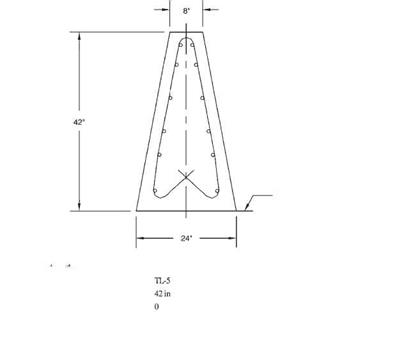BRIDGE RAILINGS AND TRANSITIONS
Bridge railings are longitudinal barriers intended to prevent vehicles from running off the edge of a bridge. A metal post-and-rail system, a concrete safety shape, and various combinations have been used. Bridge railings are attached to the structure and designed to have minimal deflection under impact. The AASHTO Standard Specifications for Highway Bridges require that bridge railings meet specific geometric criteria and resist specified loads without exceeding allowable stresses. However, the AASHTO LRFD Bridge Design Specifications provide the most current design criteria, based on NCHRP Report 350. While AASHTO specifications do not prescribe bridge rail crash testing, the Federal Highway Administration (FHWA) does require that all bridge railings used on the National Highway System be of a crash-tested design. Existing railings designed to prior AASHTO specifications or crash-tested under earlier guidelines may be acceptable through evaluation of in-service performance.
![]()
 AASHTO Designation:
AASHTO Designation:
Test Level:
Nominal Barrier Height: Maximum Dynamic Deflection:
Remarks: This barrier is suitable for both permanent and temporary applications, Its primary advantage is that the adjacent pavement can be overlaid several Limes without affecting the performance of the barrier. Its disadvantage is that greater vehicle damage occurs at shallower impact angles compared to other safety-shape barriers.
FIGURE 6.34 Single-slope concrete median barrier. Conversion: 1 in = 25.4 mm. (From Roadside Design Guide, AASHTO, Washington, D. C., 2002 and 2006, with permission)
6.11.1 Selection Considerations
The selection of a railing should include consideration of the following five factors:
Railing performance. There must be evidence that the system will provide the desired performance level. Design to current AASHTO LRFD Bridge Design Specifications and crash-testing to NCHRP Report 350 is recommended. Compatibility. A crashworthy transition section is required if the approach barrier significantly differs in strength, height, or deflection characteristics.
Cost. Life-cycle cost analysis is desirable to compare alternatives. Initial costs, maintenance costs, and the costs of accidents must be considered.
Field experience. Review in-service performance of existing systems to evaluate effectiveness and cost.
Aesthetics. Appearance is particularly important in scenic areas, but systems must be selected that meet required performance levels.






Leave a reply